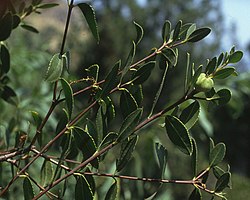| Hippomaninae | |
|---|---|
 | |
| Colliguaja odorifera | |
| Scientific classification | |
| Kingdom: | Plantae |
| Clade: | Tracheophytes |
| Clade: | Angiosperms |
| Clade: | Eudicots |
| Clade: | Rosids |
| Order: | Malpighiales |
| Family: | Euphorbiaceae |
| Subfamily: | Euphorbioideae |
| Tribe: | Hippomaneae |
| Subtribe: | Hippomaninae |
| Genera | |
See text | |
Hippomaninae are plants of the family Euphorbiaceae. It is a subtribe of the Hippomaneae and has 32 genera:
- Actinostemon
- Adenopeltis
- Anomostachys
- Balakata
- Bonania (also called Hypocoton)
- Colliguaja
- Conosapium
- Dalembertia (also called Alcoceria)
- Dendrocousinsia
- Dendrothrix
- Ditrysinia
- Duvigneaudia
- Excoecaria (also called Commia, Glyphostylus)
- Falconeria
- Grimmeodendron
- Gymnanthes (also called Adenogyne, Ateramnus)
- Hippomane (also called Mancanilla, Mancinella)
- Mabea
- Maprounea (also called Aegopicron, Aegopricon, Aegopricum)
- Microstachys
- Neoshirakia (also called Shirakia)
- Pleradenophora
- Pseudosenefeldera
- Rhodothyrsus
- Sapium (also called Carumbium, Gymnobothrys, Sapiopsis, Seborium, Stillingfleetia, Taeniosapium), Chinese tallow
- Sclerocroton
- Sebastiania (also called Clonostachys, Cnemidostachys, Elachocroton, Gussonia, Microstachys, Sarothrostachys, and Tragiopsis)
- Senefeldera
- Senefelderopsis
- Shirakiopsis
- Spegazziniophytum
- Spirostachys
- Stillingia (also called Gymnostillingia)
- Triadica